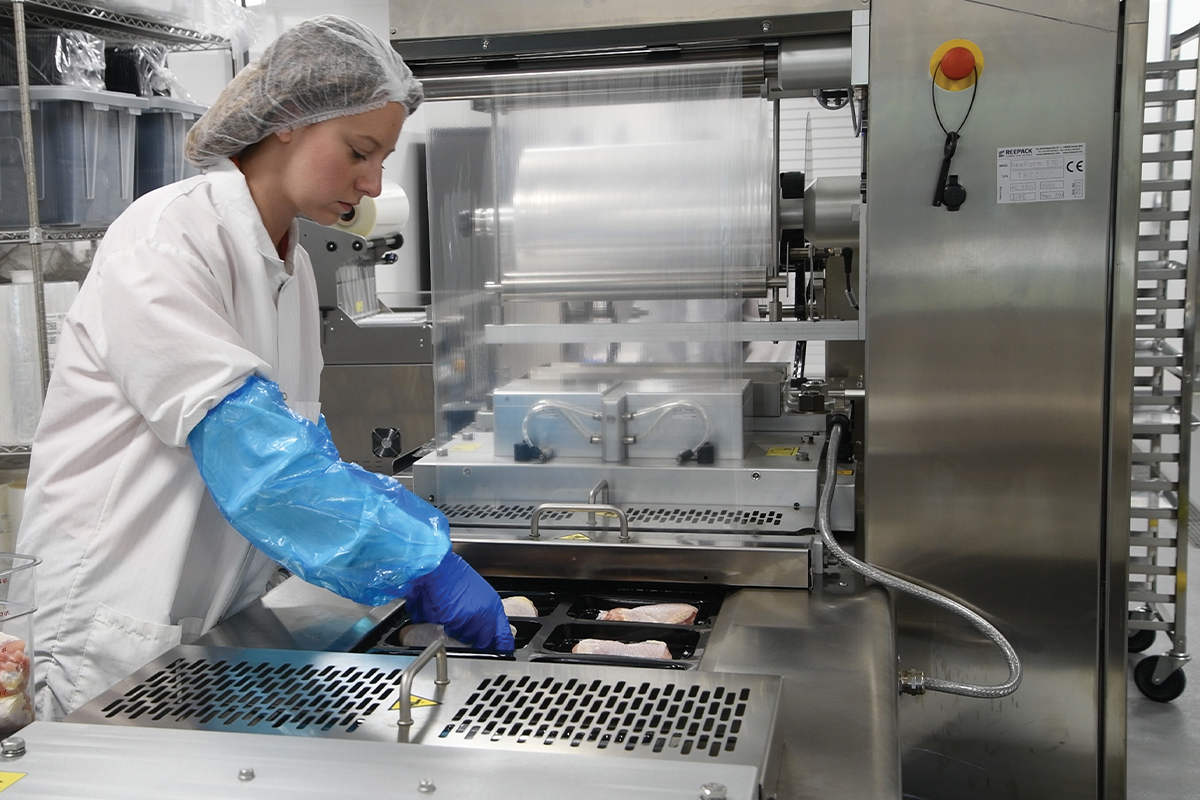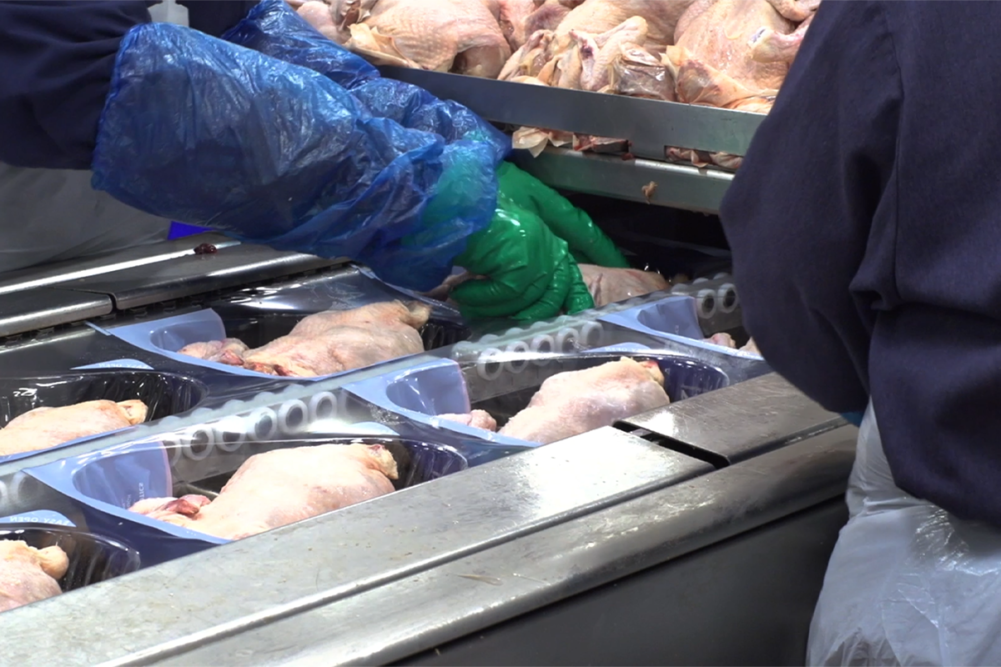Whole bird poultry offers many advantages to consumers and restaurateurs alike. Cost savings tops the list for most, but many prefer whole birds for other reasons.
A whole chicken provides two wings, two single lobe breasts, two leg quarters, two chicken tenders, and a backbone, and once broken down, any unused parts can be frozen and used at a later time. Another reason buyers choose whole birds is size. Chicken parts usually come from bigger birds, a medium or smaller bird is known to have meat, especially the breast, that is more tender. Once cook or chef removes all the meat, bones and everything left can be used to make stock. All of these attributes give whole bird poultry high value.
Processors need to follow the same standards when packaging whole birds as they do when packaging parts, whether it be turkeys, chickens, duck or otherwise. Customers desire and are attracted to the same packaging attributes for all food, including whole birds.
Whole bird basics
Products in a retail environment can easily blend in with the products around them. The fresh and frozen poultry cases tend to have various products, and often packaging stands out to shoppers. In addition, customers will always ask the question of quality and safety.
“Packaging in the crowded retail environment demands an exclusive and premium appearance to attract consumers, while also focusing on freshness of the product,” said Greta Shimon, marketing manager at Amcor Flexibles North America, Oshkosh, Wis.
Poultry processors have access to many types of whole bird packaging options, depending on what their customers prefer and need. Materials, reliable machinery and ease of use all play roles in a high quality whole bird packaging solution.
“While every processor is unique, in general the ideal whole bird packaging solution is one that delivers excellent package quality with high availability and minimized maintenance requirements,” said Ryan Spencer, product marketing manager, Multivac Inc., Kansas City, Mo. “It also would be capable of automation to reduce the number of people needed to operate the line.”
Formats for whole bird packaging include shrink bags, rollstock, trays and lids and vacuum packaging films. Processors and suppliers work together on whole birds to maximize appearance and eliminate odors through package breathability while maintaining freshness. Both heat sealing and clipping are used for closure.
“There is also the possibility to package whole birds with a MAP [modified atmosphere packaging] pack on a flow wrapping packaging machine,” Spencer said. “Each method has their pros and cons. The chamber vacuum machines using bags are very flexible for running other products of other sizes, but loading the product into the bags can be challenging. Using a thermoforming packaging machine produces superb package appearance, but the cost is higher. And flow wrapping can deliver a high output, but the resulting packaging doesn’t provide the tight look that is nearly standard in the marketplace.”
Costs continue to weigh heavily on processors whether they be materials or labor. Cutting or maintaining packaging costs and getting a better return on investment provide one way for processors to keep expenditures in check.
“Amcor’s Form-Tite and Flow-Tite shrink rollstock lower labor costs by 50% or more,” Shimon said. “Shrink rollstock films in conjunction with shrink equipment deliver an overall cost reduction by optimizing your productivity while maintaining advanced protection.”
 Freshness, sustainability and appearance are all important factors when packaging whole birds. (Source: Ossid)
Freshness, sustainability and appearance are all important factors when packaging whole birds. (Source: Ossid)Poultry packaging preferences
Packaging suppliers in close contact with processors hear firsthand the major concerns processors have regarding whole bird packaging. The rate of processing, leakers, required labor and physical footprint in the plant, as well as shelf life to meet supply chain demands are all of paramount importance.
“Innovations to reduce packaging materials and integrate features like grab-and-go handles also provide cost savings,” Shimon said.
Spencer added that offering processors high-output, minimal leakers, the ability to automate some to most of the processes and efficient straight-line production all put poultry facilities in a better overall position to not only produce and sell more product to customers, but ultimately create great relationships with them and consumers alike.
Shimon said data from the latest 52 weeks ending June 18, 2023, from the Circana Integrated Fresh MA Database, showed volume sales have increased compared to a year ago for all cuts of chicken except breast and whole bird and whole bird sales are the weakest performer in the total chicken category.
“So, differentiation is extremely important,” she added.
Enhanced graphics, packaging sustainability, extended shelf life and convenience packaging features, such as handle bags, have become differentiating innovations that could potentially win consumers over from the case.
“There have been steps forward to make the packaging more attractive and easier to use for the consumer,” Spencer said. “A few examples include adding an easy open tab, packaging with handle holes to make it easier to carry and transport, and even cook-in bags that allow the consumer to put the product and package directly into the oven to cook.”
He added, “Customers are often fickle and hard to please, but with whole bird packaging it seems to be fairly simple, they want a package that forms tightly around the bird and does not show purge. An opening feature is very nice to have to minimize the mess in the prep area.”
Working together
Processors and suppliers must always communicate effectively when putting a plan together for figuring out the best possible solution for packaging projects. For some it might be a complete turnkey solution, or it might be pieced together or integrating a single machine, or multiple pieces, into an existing production line.
Suppliers need to offer customers equipment and services, but also specialized attention and services that ensure lasting relationships and collaboration into the indefinite future.
“In addition to equipment options and partnerships, Amcor offers Calibrate technical service and support to keep your production lines running smoothly, today and in the future,” Shimon said. “Our Calibrate services help our customers optimize the machine and material interface, improving uptime, throughput and quality through inspections, line audits, trainings, preventative maintenance and supplying equipment and parts.”
Good communication ensures all parties involved in a project have the same understanding of what is needed and how each piece of a solution will be pursued and who is responsible for what, etc. When everyone knows these things, projects will run as smoothly as possible to work toward achieving goals with efficiency and on deadlines.
“The biggest challenge to designing whole bird packaging solutions is getting it right the first time,” Spencer said. “Often processors will change their minds on key points, forcing retrofits to be necessary that can add cost. Thankfully, Multivac has a lot of experience and knowledge to avoid these types of situations by asking the right questions up front.”



